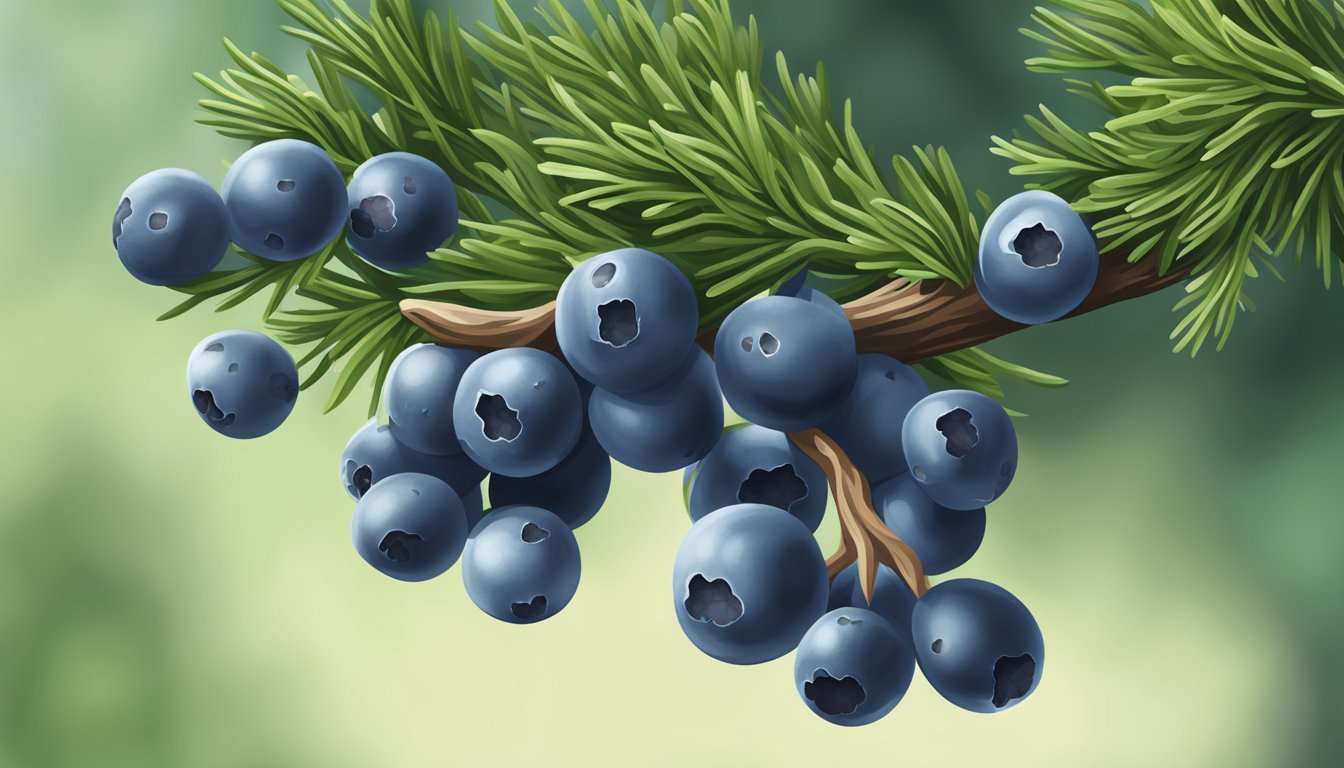How Long Do Juniper Berries Last?
Shelf Life and Storage Tips
Juniper berries (how long do juniper berries last?) are a unique and versatile ingredient known for their spicy, fragrant flavor which can be used both in culinary and medicinal contexts. These berries, produced by juniper trees and shrubs, take a considerable amount of time to mature, often requiring up to three years depending on the species. In terms of shelf life, juniper berries can last quite long if stored properly; fresh berries can maintain their quality for several months, while dried juniper berries can last for up to two years without losing their potent aroma and flavor.
Determining the ripeness of juniper berries is essential for their proper use and longevity. They do not ripen uniformly, which means that a single tree can have berries at different stages of maturity. The ideal time to harvest is when the berries are fully ripe, which can be ascertained by a gentle tug—if the berry comes away from the branch easily, it is ready to be picked. Once harvested, the storage method plays a crucial role in preserving the berries' longevity. Fresh juniper berries should be kept in a cool, dry place away from direct sunlight, while dried berries should be stored in an airtight container to extend their useable life.
Juniper Berries Overview
Juniper berries are the female seed cones produced by the various species of junipers, which are coniferous trees or shrubs in the genus Juniperus of the cypress family. These cones typically have a berry-like appearance and therefore receive the common name "berry." Despite this, they are not true berries but rather a cone with unusually fleshy and merged scales.
The junipers are evergreen and can be found as both trees and shrubs. They are often native to more temperate regions of the Northern Hemisphere and thrive in a variety of environmental conditions. They are known to be long-lived, with some species such as the Rocky Mountain juniper (Juniperus scopulorum) capable of living for several centuries.
In terms of ripeness and harvest, juniper berries do not all mature at the same time; even on a single tree or shrub, berries at various stages of ripeness can be observed. The maturation process can differ widely among species, ranging from as little as 8–10 months to over 24 months.
Their use is varied:
Culinary: Ripe, dark berries are used in European cuisine, lending a sharp, clear flavor to dishes.
Alcohol production: Specific junipers, with their unripe green berries, are used to flavor gin.
Medicinal: These berries have been reported to contain compounds that provide potential health benefits.
Juniper berries are often described as having a piney, somewhat peppery flavor with citrus notes. They pair well with a range of herbs and spices such as thyme, sage, and marjoram, making them a versatile ingredient in the kitchen.
Characteristics of Juniper Berries
In the genus Juniperus, the berries are renowned for their unique appearance and complex flavor profile, which contribute to their use in culinary and medicinal applications.
Physical Traits
Juniper berries are not true berries but are actually modified cones with unusually fleshy and merged scales giving them a berry-like appearance. They generally have a round shape and a firm texture when mature, with a size that typically ranges from 4 to 12 millimeters in diameter.
Color and Ripeness
The color of juniper berries progresses from green to blue or dark purple as they mature. This transformation can often be observed on a single plant, where one might see both young green and fully ripe blue or purple berries concurrently. It is common for the berries to take up to three years to reach full maturity.
Green: unripe, tender
Blue/Dark purple: ripe, ready for harvest
Flavor Profile
The flavor of juniper berries is quite distinctive, combining bitter and sweet elements with a resinous, woodsy taste. Notes of citrus are also present, contributing to the complexity that makes juniper berries a versatile and valued ingredient. When fresh, they offer a more pronounced flavor, while drying can mellow their intensity somewhat while concentrating their essential oils.
Culinary Uses of Juniper Berries
Juniper berries offer a distinctive flavor profile that is versatile in culinary applications, ranging from flavoring meats to creating aromatic spirits and teas. Their use is deeply rooted in tradition but also woven into modern cooking practices.
Inclusion in Recipes
Juniper berries are primarily valued as a spice, imparting a sharp, clear flavor that often combines well with gamey meats and robust stews. They serve as a conventional ingredient in European cuisine, particularly in dishes from Scandinavian and Eastern European countries. Key uses include:
Meat Seasoning: A common inclusion in rubs for lamb, venison (What wine goes well with venison?), and pork.
Desserts: Occasionally found as an adventurous note in fruitcakes and cookies.
Cooking Liquids: Often added to braising broths and marinades to infuse a pine-like taste.
Sauces: Crushed berries can complement cream-based sauces or chutneys with a bittersweet zest.
Gin Production
The most recognized use of juniper berries is in the production of gin, where they are the primary botanical providing the spirit's characteristic taste. Originating from the Dutch jenever, gin has evolved into a popular alcoholic beverage worldwide. The berries are distilled with alcohol, releasing their flavorful oils, which give gin its unique, crisp profile.
Traditional Medicinal Uses
Historically, juniper berries have been used for their medicinal properties, often linked to digestive and anti-inflammatory benefits. They continue to have a place in alternative medicine where they are used in:
Tea: Steeped to create an herbal infusion believed to aid in digestion and cleanse toxins.
Natural Remedy: Employed in traditional health practices to treat a range of ailments, from urinary tract infections to joint pain.
In culinary circles, the versatility and distinct flavor of juniper berries keep them relevant across various platforms, from the kitchen to the distillery.
Growth and Harvesting
Juniper berries require a period of growth that spans across multiple years before they are ready for harvest. This phase is crucial to ensure a full, ripe yield.
Harvest Time
Juniper berries take approximately two to three years to mature. The ideal time for harvesting is fall, when the berries have turned a deep blue color, signaling peak ripeness. A ripe berry will come off the branch with a gentle tug. It should be noted that not all berries ripen simultaneously on the same tree or shrub, as junipers tend to have berries at various stages of maturity.
First Year: Flowers form on the junipers.
Second Year: Development of a hard green berry.
Third Year: Berries ripen to a deep blue.
During harvesting, one should be prepared to encounter juniper needles, which can be sharp; hence, wearing gloves is recommended. One should only pick the ripe berries and leave the others to mature or for birds to forage.
Ideal Growing Conditions
Juniper berries thrive best in a long, warm growing season, with temperatures ranging between 60°F and 70°F. They also require cool winters maintaining a temperature range between 30°F and 50°F. For optimal growth, junipers should be planted in an area that receives full sun and in well-drained soils. This ensures that the plants receive enough light and heat, while also avoiding the pitfalls of overly wet roots, which can be detrimental.
Sunlight: Full sun is necessary.
Soil: Well-drained soils are ideal.
Temperature: 60°F to 70°F during growing seasons and 30°F to 50°F in winter.
Proper planting and care for junipers will result in a successful harvest of ripe berries, providing the distinctive flavor for culinary uses or various traditional remedies.
Preservation and Storage
Juniper berries, when harvested at the peak of ripeness, can be stored effectively if handled properly. For fresh juniper berries, immediate refrigeration is recommended to extend their shelf life. They should ideally be placed in a breathable container to prevent moisture accumulation and consequent mold growth. Under these conditions, fresh berries can last for several months.
For long-term storage, drying the berries is a preferred method. To ensure proper drying, one should spread the berries out in a single layer, giving them ample space to dehydrate evenly. Once completely dry, juniper berries must be stored in an airtight container, away from direct sunlight and heat sources. If stored correctly, dry berries can remain edible for up to several years.
Recommended Storage Practice:
Fresh Berries:
Refrigerate immediately
Use breathable containers
Consume within a few months
Dry Berries:
Dry thoroughly before storage
Keep in airtight containers
Store in a cool, dark place
Can last for several years
Care should be taken to check on the berries periodically to ensure that they have not absorbed moisture or developed mold. By adhering to these storage guidelines, one can maintain the potency and flavor of juniper berries for both immediate use and future culinary applications.
Health Benefits and Risks
Juniper berries have long been recognized for their medicinal properties, though they also pose potential risks if consumed improperly or in excessive quantities.
Medicinal Properties
Juniper berries are traditionally used in medicine to aid the urinary tract, including treating urinary tract infections (UTIs). They have anti-inflammatory properties and contain essential oils and compounds that may benefit kidney health. The berries are also noted for their antioxidant capacity due to compounds like monoterpenes, which include substances like limonene, camphor, and beta-pinene. These components are believed to contribute to the berries' health effects by offering antibacterial and antioxidant benefits.
Potential Toxicity
However, despite their medicinal benefits, juniper berries can be toxic to the liver and kidneys when consumed in large quantities or over extended periods. This is due to specific compounds present in the essential oils of the berries. The term "toxic" is applicable as consuming high doses can lead to issues such as renal irritation or digestive problems. It's crucial to consume juniper berries in moderation, and individuals with pre-existing liver or kidney conditions should be particularly cautious.
Wildlife and Ecosystem
In the wildlife and ecosystem context, Juniper berries play a crucial role as a source of forage for various species while contributing significantly to their surrounding ecological dynamics.
Juniper Berries as Forage
Birds and wild mammals often rely on Juniper berries for sustenance. These berries are particularly important in winter when other food sources are scarce. Bird species, such as the cedar waxwing, thrive on these nutrient-rich berries, which also help sustain their energy needs during migration periods. Furthermore, foraging on Juniper berries is not limited to birds; many mammalian species, including deer, also consume these berries to supplement their diet.
Primary Foragers:
Birds: Cedar Waxwings, Robins
Mammals: Deer, Coyotes
The presence of wild yeast on the surface of Juniper berries is of interest, as it suggests their potential role in natural fermentation processes important to certain species' digestive systems.
Ecological Significance
Juniper trees themselves, from which the berries come, are keystones in their ecosystems. Not only do they provide essential forage, but they also offer shelter and breeding grounds for a variety of creatures. The dense foliage gives protection from harsh weather and predators while also acting as nesting sites. On a larger scale, Juniper-dominated landscapes contribute to the overall health of habitats by retaining soil moisture and providing food resources during critical seasons.
Cultural Significance and History
The cultural significance of juniper berries spans many regions and eras, deeply engrained in both ancient traditions and modern practices.
Juniper in Folklore and History
Juniper has a storied presence in history and folklore, particularly within Europe and North America. Historical records from ancient Egypt reveal that juniper berries were used as early as 1500 BC in remedies for various ailments, such as tapeworm infestations. The Romans appreciated juniper berries for their supposed purification properties and their use in treating stomach issues. In European folklore, the plant has been considered a protective herb. Juniper, specifically Juniperus communis, thrived across the Northern Hemisphere, and both its timber and berries have been valued for various uses throughout history.
In North America, the Eastern red cedar (Juniperus virginiana), despite its name, is a juniper species widely recognized for its robustness and the cultural worth of its berries and wood. Native American tribes employed juniper berries from different species for culinary, medicinal, and ceremonial purposes, revealing the plant's versatility and regional importance.
Modern Cultural Practices
Today, juniper remains culturally significant, with Juniperus communis berries being a key ingredient in gin production, a practice that began in the 17th century in the Netherlands and spread across Europe. Besides this, the use of juniper wood and berries continues in various cultural forms, including crafts, fragrances, and traditional medicines. In China, Juniperus sabina is utilized in traditional Chinese medicine, demonstrating juniper's global cultural relevance.
The use of juniper berries in modern culinary practices is not limited to alcohol production; it also includes use as a spice for flavoring dishes, highlighting the ongoing intersection between juniper's historical roots and contemporary culinary arts. The plant's resilience and the versatility of its berries have ensured its enduring presence in cultural practices across the globe.
Practical Tips for Consumers
When purchasing and using juniper berries, consumers should focus on selecting ripe, high-quality berries and incorporating them effectively in home usage for culinary purposes.
Selecting Quality Berries
For optimal freshness and flavor, choosing ripe juniper berries is crucial. Berries should be deep blue, a sign they are ripe and have reached full maturity. When handling juniper berries, consumers are advised to wear gloves to protect their hands from the shrub's sharp leaves. A ripe berry should come off the plant with a gentle tug or shake of the branch—if it resists, it's likely not ready.
Using Juniper Berries in the Home
Once selected, juniper berries can be a robust addition to various dishes. They pair well with meats like venison and can add a unique flavor to sauerkraut. To utilize their full potential:
Crush the berries before adding them to impart more flavor.
Use berries as a pepper substitute to season dishes.
Create aromatic cocktails by infusing spirits with a few juniper berries.
An excellent combination is juniper berries with sage in gamey meats for a harmonious Earthy taste. When using juniper berries in cooking, remember that a little goes a long way due to their strong flavor profile.
Growing Juniper at Home
Growing juniper as either a tree or shrub at home requires understanding the right propagation techniques and meticulous maintenance, including regular pruning. This section will guide homeowners on the successful cultivation of junipers.
Propagation and Planting
To propagate junipers at home, one can start with seeds or cuttings. Juniper seeds typically require stratification, a process of simulating winter conditions to break dormancy, before sowing. This is typically done by mixing the seeds with slightly moist sand and refrigerating them for 90-120 days. After stratification, plant the seeds in well-draining soil under full sun exposure. For cuttings, select a healthy branch during the late winter, dip the end in rooting hormone, and plant it in a mixture of sand and peat.
Junipers are versatile and can adapt to dry conditions but they flourish in well-draining soil with a pH of 6.0 to 8.0. When planting, ensure adequate space for growth, considering mature junipers can spread widely depending on the species. Water the newly planted junipers thoroughly and place a tarp around the base to discourage weed growth and retain soil moisture.
Maintenance and Pruning
Maintenance of juniper plants primarily involves watering, monitoring for diseases such as rust, and ensuring they are not overcrowded to prevent competition for nutrients. Junipers generally prefer drier conditions and thus, overwatering should be avoided. Use a farm-grade watering system if available to provide a gentle supply of water, mimicking natural rainfall.
Pruning is important for juniper care to maintain shape and encourage healthy growth. It's best done in the late winter to early spring. When pruning, always use clean, sharp tools to make precise cuts. Remove any dead or diseased needles and branches to improve air circulation. Take care not to cut into the older bark areas that don’t regenerate as easily. For larger juniper trees, it may be necessary to remove whole branches, making cuts close to the trunk, but never leaving large, stubby holes.
Homeowners must avoid using chemicals that may damage the juniper’s sensitive roots and always wear gloves to protect against the sharp needles of juniper branches. Regular observation can prevent issues with pests and disease that are common in cedars and related species, ensuring the health and longevity of the juniper plants at home.












